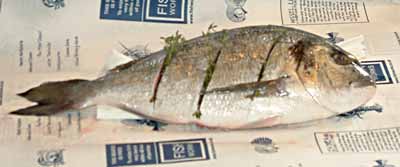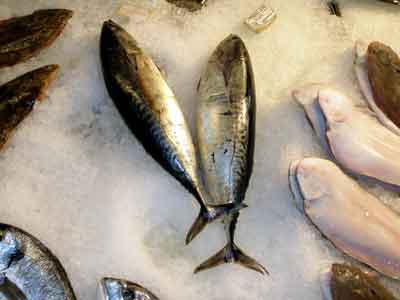
Sea bream. A firm, lean, white-fleshed fish unlike the bream of other waters. Raw and sliced it makes a fine sashimi.
Paper thin slices of sea bream traditionally fanned out on a leaf-shaped plate and served with ponzu sauce.

Little tunny. The little tunny is a handsome fish with black scribble patterns on its back. It has a robust, torpedo-shaped body built for powerful swimming and it has no swim bladder. The mouth is large, the lower jaw slightly protruding past the upper jaw. The flesh of the little tuna is darker and stronger tasting than that of the other large tunas. It is marketed fresh, dried, canned, smoked, or frozen. It is often caught on hook and line near reefs.
The name in western Japan for nimono, or simmered dishes, are traditionally served in the latter half of a kaiseki banquet. Since several dishes have already been consumed by the time the nimono is served, the contents of the nimono will vary according to what has already been presented. For example, if fish or meat has been served previously, then the nimono will likely feature vegetables. In this way, the nimono is planned to harmonize with the entire menu. If such a dish is produced, the greens are cooked briefly in boiling water and then removed to iced water to keep their colour. Root vegetables are parboiled in cold water which is brought to the boil quite fast, strained and cooled with a hand-held fan. They are then all immersed in dashi to which mirin and other flavourings are added. In restaurant-style kaiseki, courses are served on lacquered trays without legs and are enjoyed one at a time. The menu generally consists of a sakizuki (appetiser), a suimono (clear soup), a mukozuke (usually slices of raw fish), a kuchigawari (palette refresher), a yakimono (something grilled), a nimono (something boiled or simmered), an aizakana (something steamed or deep-fried), a sunomono (something vinegared) and a tomewan (final dish). On the simplest level a kaiseki course consists of one soup and three side dishes (rice and pickles are included but are not numbered among the dishes). Aemono are highly decorative salads designed to complement any of these courses.